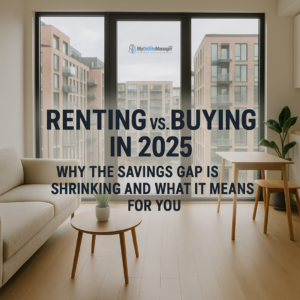For years, the narrative has been clear: renting saves money while buying requires deep pockets. In fact, throughout the pandemic and its aftermath, skyrocketing home prices and rising mortgage rates pushed buying further out of reach, leaving renting as the more practical option for most households.
But now, new data shows that the financial advantage of renting once measured in nearly $1,000 in savings per month compared to buying is starting to slip. Renters are still coming out ahead in nearly every major U.S. metro, but the cushion is thinner than it used to be.
So, what’s behind this shift? And what should renters and aspiring homeowners take away from these numbers? Let’s break it down.
Key Numbers at a Glance
-
Median U.S. rent (0–2 bedrooms): $1,711 in June 2025
-
Year-over-year rent change: –2.1% (a $36 drop)
-
Compared to 2019: +18.6% (rents still well above pre-pandemic levels)
-
Renting vs buying: Renting saves an average of $908/month, down from $956 last year
-
Metros where renting is cheaper than buying: 49 out of 50
-
Only exception: Pittsburgh, where buying beats renting by ~$111/month
Where Renting Still Dominates
In most major metros, renting is still clearly the cheaper option. Let’s look at some examples:
-
Austin, TX – Buying costs 114.7% more than renting, making Austin one of the most renter-friendly cities in the U.S.
-
San Jose, CA – Renters still save big, though their advantage shrank by $349 per month compared to last year.
-
Dallas-Fort Worth, TX – Renting remains cheaper, but the gap narrowed by $272/month.
Even in metros where rents remain elevated, the combined burden of mortgage rates, property taxes, and insurance keeps renting more affordable in the short term.
Where the Gap Is Narrowing Fast
The biggest story in this data isn’t about where renting is still cheaper (which is nearly everywhere). It’s about where the savings from renting are eroding:
-
San Jose, CA: Advantage shrank by $349/month
-
Austin, TX: Advantage shrank by $292/month
-
Dallas-Fort Worth, TX: Advantage shrank by $272/month
-
Seattle, WA: Advantage shrank by $210/month
-
Columbus, OH: Advantage shrank by $201/month
This trend suggests that as rents fall slightly and home prices stabilize, the long-standing dominance of renting may no longer be as obvious in every market.
Where Renting’s Edge Is Growing
Interestingly, not all metros follow the national trend. Some are moving in the opposite direction where renting is becoming more financially favorable than buying:
-
Birmingham, AL: Renting’s advantage grew by $189 in the past year
-
Milwaukee, WI: Renting’s edge increased by $136
-
Memphis, TN: Flipped entirely from favoring buying to favoring renting
These shifts highlight how local dynamics matter just as much as national trends. Supply, demand, and local economies all influence whether renting or buying is more cost-effective.
Why the Gap Is Shrinking
Several forces are at play:
-
Mortgage Rates Remain High
Even with modest declines in home prices, mortgage rates keep monthly costs high. For buyers, a 30-year fixed mortgage at 6–7% is still a significant barrier. -
Home Prices Are Stubbornly Elevated
Pandemic-era demand pushed home prices up dramatically. While prices have cooled in some areas, many metros remain well above 2019 levels. -
Rents Are Moderating
Nationwide, rents are easing after years of steep increases. This is partly due to new rental construction and a normalization of post-pandemic demand. -
Inventory Imbalances
More apartments coming online → softer rents. Limited for-sale housing supply → home prices stay high. -
Cost of Living Pressures
Insurance, property taxes, and maintenance add to homeowner costs, making renting look even more attractive even as rents creep upward in certain metros.
What This Means for Renters
-
Short-Term Wins: Renting is still cheaper and more flexible in almost every market. If you’re planning to stay less than 3–5 years, renting likely makes more sense.
-
Budgeting Advantage: The average $908/month savings can be redirected into debt repayment, savings, or investments.
-
Local Vigilance: Keep an eye on your city while nationally renting is cheaper, metros like Pittsburgh show that local conditions can flip the script.
What This Means for Aspiring Homeowners
-
Timing Matters: If you’re eyeing homeownership, waiting for mortgage rates to drop or for local home prices to soften may yield better affordability.
-
Run the Numbers: Look beyond mortgage payments. Factor in property taxes, insurance, and upkeep.
-
Equity vs Flexibility: Buying may be more expensive month-to-month, but it offers long-term equity growth. Decide what matters most short-term affordability or long-term stability.
What to Watch in 2026 and Beyond
-
Mortgage Rates: Any significant drop could tip the balance toward buying.
-
Rental Supply: Continued apartment construction could keep rents stable or push them lower.
-
Policy Shifts: First-time buyer incentives or rent stabilization measures could reshape the landscape.
-
Regional Divergence: Expect metros to move in different directions depending on local demand, wages, and supply trends.
Conclusion
For now, renters still enjoy a financial edge in 49 out of 50 metros but that edge is shrinking. The decision between renting and buying has never been more nuanced.
If you’re a renter, now is the time to take advantage of lower monthly costs while staying financially agile. If you’re a buyer, patience and timing could soon shift the numbers back in your favor.
Either way, the key takeaway is this: housing decisions are increasingly local, and staying informed is your best tool.

